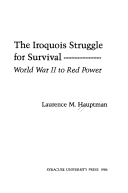Iroquois Book
1 total work
From World War II onward, the Iroquois, one of the largest groups of Native Americans in North America, have confronted a series of crises threatening their continued existence.
From the New York-Pennsylvania border, where the Army Corps of Engineers engulfed a vast tract of Seneca homeland with the Kinzua Dam, from the ambition of Robert Moses and the New York State Power Authority to develop the hydroelectric power of the Niagara Frontier (which eroded the land base of the Tuscaroras), from the construction of the Saint Lawrence Seaway (which took land from the Mohawks and still affects their fishing industry), to the present-day battles over the Oneida land claims in New York State and the Onondaga efforts to repatriate their wampum--Laurence Hauptman documents the bitter struggles of proud people to maintain their independence and strength in the modern world.
Out of these battles came a renewed sense of Iroquois nationalism and nationwide Iroquois leadership in American Indian politics. Hauptman examines events leading to the emergence of the contemporary Iroquois, concluding with the takeover at Wounded Knee in the winter-spring of 1973 and the Supreme Court's Oneida decision in 1974. His research is based on historical documents, published materials, and interviews and fieldwork in every Iroquois community in the United States and several in Canada.
